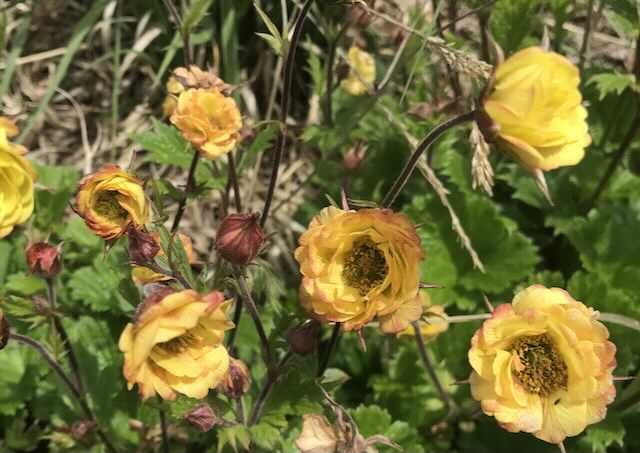
Thalictrum 'Elin'
One of the tallest thalictrum with both wonderful foliage and flower display. Good in shade or part sun, prominent background plant, one of the best varieties we have grown.


Low growing rivale type with a long flowering period, good for path edging or foreground beds, these do best in heavier soils with some fertility, but in good soil are drought hardy and will take some summer heat.
Low growing rivale type with a long flowering period, good for path edging or foreground beds, these do best in heavier soils with some fertility, but in good soil are drought hardy and will take some summer heat.
Data sheet
One of the tallest thalictrum with both wonderful foliage and flower display. Good in shade or part sun, prominent background plant, one of the best varieties we have grown.
Evergreen shrub forming an attractive rounded shape with sweetly fragrant clusters of white and pink flowers in spring.
Low growing plant for shade or part shade, with spreading ground covering habit and porcelian blue flowers. Prefers open textured soil and easily divided once established, combines well with other woodland plants like anemone, rodgersia, and epimedium.
Low growing bedding and border plant with blue flowers, lasts well in a vase and keeps producing if deadheaded.
A brilliant low grass with outstanding flowers and seedheads, suitable for massed foreground plantings in landscape design work or in clusters amongst other perennials. A slender plant so plant closely at 25cm for best results. Not self seeding in our trial stockbeds.
A dark flowered seedling I selected at Richard Bramleys "Farmyard Nursery" in Wales. An improvement on "Moerheim Beauty", with deep orange red flowers in mid to late summer.
A terrific subulata ground covering variety, hundereds purple flowers in spring an a good groundcovering habit, likes some drainage but not overly fussy and can tolerate drying out in summer..
A cold tolerant highbush variety with a long fruiting period, reputedly self fertile, however combining varieties improves pollination generally.
Attractive shrub for the sunny border with apricot foxglove-like flowers in summer. Very drought tolerant but doesn't like frost.
One of the best achillea for foliage structure, the flowers are at their best pre colouring when the combination of grey flower buds and silvery foliage provide a lovely texture amongst summer perennials.
Lower growing hosta with lots of lilac flowers and good rosettes of blue grey foliage. Useful variety for foreground plantings in part sun to shade.
Blue grey leaves, sieboldiana cross distinguished by its symmetrically pointed leaves, forms a good clump in shade.
A beautiful new variety from our trial beds; flowers open white with a blush of pink on the underside, good stem length and vigour compared to other varieties. Grow in a cool damp spot on rich soil, winter deciduous as per other astrantia. Pinch out first flower to help roots develop.
Dome-forming clumper for the rockgarden or border, flowering profusely during summer with mounds of purple bells. Non-invasive and generally tidy when not in flower. Dislikes acid soil.
Vigourous form of white wind flower for shade or part sun, this is a variation with slightly narrower multiple layered petals. Drained fertile soils improve flowering performance.
Spectacular clumping Iris for pond sides and moisture retentive soils, big blue flowers in summer. For grouped plantings plant 20-25cm apart for best results.

Low growing rivale type with a long flowering period, good for path edging or foreground beds, these do best in heavier soils with some fertility, but in good soil are drought hardy and will take some summer heat.